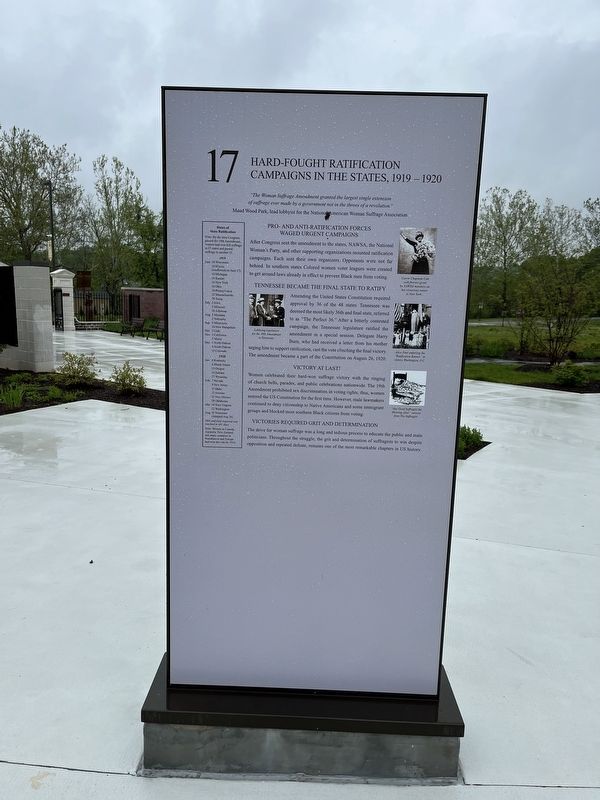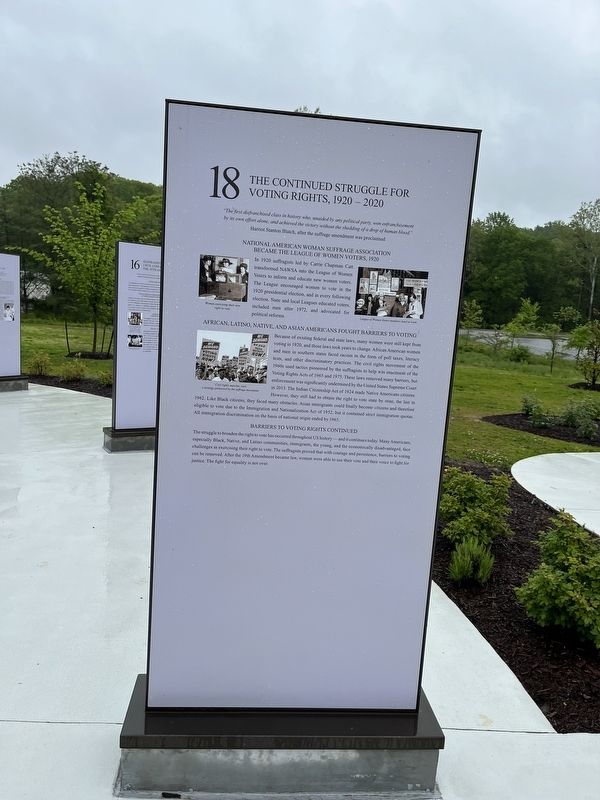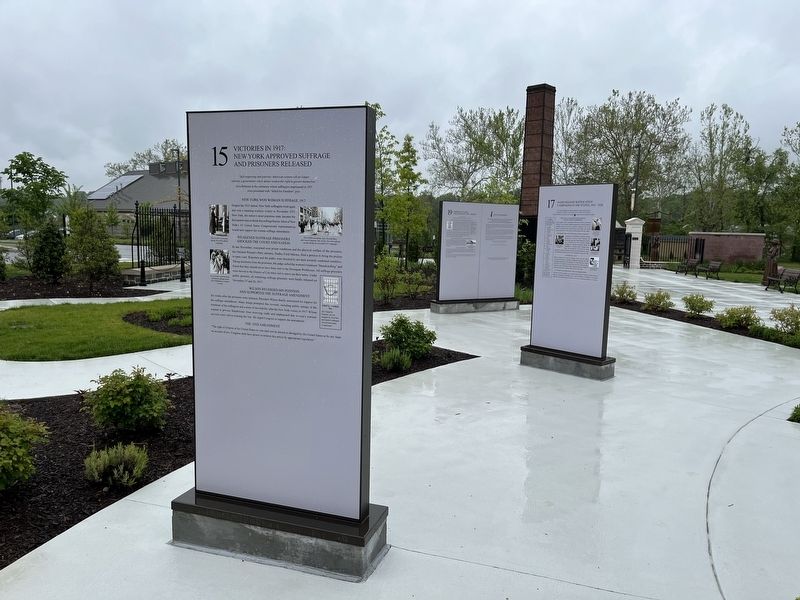Lorton in Fairfax County, Virginia — The American South (Mid-Atlantic)
Hard-Fought Ratification Campaigns in the States / The Continued Struggle for Voting Rights

Photographed By Devry Becker Jones (CC0), May 6, 2022
1. Hard-Fought Ratification Campaigns in the States side of the marker
Hard-Fought Ratification Campaigns in the States, 1919-1920
"The Woman Suffrage Amendment granted the largest single extension of suffrage ever made by a government not in the throes of a revolution."
Maud Wood Park, lead lobbyist for the National American Woman Suffrage Association
Pro- and Anti-Ratification Forces Waged Urgent Campaigns
After Congress sent the amendment to the states, NAWSA, the National Woman's Party, and other supporting organizations mounted ratification campaigns. Each sent their own organizers. Opponents were not far behind. In southern states Colored women voter leagues were created to get around laws already in effect to prevent Black men from voting.
Tennessee Became the Final State to Ratify
Amending the United States Constitution required approval by 36 of the 48 states. Tennessee was deemed the most likely 35th and final state, referred to as "The Perfect 36." After a bitterly contested campaign, the Tennessee legislature ratified the amendment in a special session. Delegate Harry Burn, who had received a letter from his mother urging him to support the ratification, cast the vote clinching the final victory. The amendment became part of the Constitution on August 26, 1920.
Victory at Last!
Women celebrated their hard-won suffrage victory with the ringing of church bells, parades, and public celebrations nationwide. The 19th Amendment prohibited sex discrimination in voting rights; thus, women entered the US Constitution for the first time. However, male lawmakers continued to deny citizenship to Native Americans and some immigrant groups and blocked most southern Black citizens from voting.
Victories Required Grit and Determination
The drive for women suffrage was a long and tedious process to educate the public and male politicians. Throughout the struggle, the grit and determination of suffragists to win despite opposition and repeated defeats, remains one of the most remarkable chapters in US history.
[Sidebar:]
Dates of State Ratification Note: By the time Congress passed the 19th Amendment, women had won full suffrage in 15 states and partial suffrage in another 15.
1919 June10 WisconsinJuly
10 Illinois (reaffirmed on June 17)
10 Michigan
16 Kansas
16 New York
16 Ohio
24 Pennsylvania
25 Massachusetts
28 Texas2 Iowa
3 Missouri
28 Arkansas Aug2 MontanaSep
2 Nebraska8OctMinnesotaPhotographed By Devry Becker Jones (CC0), May 6, 20222. The Continued Struggle for Voting Rights side of the marker
10 New Hampshire2 UtahNov1 CaliforniaDec
5 Maine1 North Dakota
4 South Dakota
15 Colorado
1920 Jan6 KentuckyFeb
6 Rhode Island
13 Oregon
16 Indiana
27 Wyoming7 NevadaMar
9 New Jersey
11 Idaho
12 Arizona
21 New Mexico
28 Oklahoma10 West VirginiaAug
22 Washignton18 Tennessee (Adopted Aug 26)
36th and final required vote reached in 441 days.
Note: Women in Canada, Australia, New Zealand and Scandinavia and Europe had won the vote by 1919.
[Captions:]
Carrie Chapman Catt with flowers given by NAWSA members on her victorious return to New York.
Lobbying legislators for the 19th Amendment in Tennessee.
Alice Paul unfurling the "Ratification Banner" in victory, Washington, D.C.
"Any Good Suffragist the Morning After," cartoon from The Suffragist
The Continued Struggle for Voting Rights, 1920 - 2020
"The first disenfranchised class in history who, unaided by any political party, wonenfranchisement by its own effort alone, and achieved the victory without the shedding of a drop of human blood."Photographed By Devry Becker Jones (CC0), May 6, 20223. The three last markers in the display are shown.
Harriot Stanton Blatch, after the suffrage amendment was proclaimed
National American Woman Suffrage Association Became the League of Women Voters, 1920
In 1920 suffragists led by Carrie Chapman Catt transformed the NAWSA into the League of Women Voters to inform and educate new women voters. The League encouraged women to vote in the 1920 presidential election, and in every following election. State and local Leagues educated voters, including men after 1972, and advocated for political reforms.
African, Latino, Native and Asian Americans Fought Barriers to Voting
Because of existing federal and state laws, many women were still kept from voting in 1920, and those laws took years to change. African American women and men in southern states faced racism in the form of poll taxes, literacy tests, and other discriminatory practices. The civil rights movement of the 1960s used tactics pioneered by the suffragists to help win enactment of the Voting Rights Acts of 1965 and 1975. These laws removed many barriers, but enforcement was significantly undermined by the United States Supreme Court in 2013. The Indian Citizenship Act of 1924 made Native Americans citizens. However, they still had to obtain the right to vote state by state, the last in 1962. Like Black citizens, they faced many obstacles. Asian immigrants could finally become citizens and therefore eligible to vote due to the Immigration and Nationalization Act of 1952, but it contained strict immigration quotas. All immigration discrimination on the bases of national origin ended by 1965.
Barriers to Voting Rights Continued
The struggle to broaden the right to vote has occurred throughout US history — and it continues today. Many Americans, especially Black, Native, and Latino communities, immigrants, the young, and the economically disadvantaged, face challenges in exercising their right to vote. The suffragists proved that with courage and persistence, barriers to voting can be removed. After the 19th Amendment became law, women were able to use their vote and their voice to fight for justice. The fight for equality is not over.
[Captions:]
Women exercising their new right to vote.
League of Women Voters members hard at work.
Civil rights marches were a strategy pioneered by the suffrage movement.
Erected 2021 by Turning Point Suffragist Memorial Association. (Marker Number 17/18.)
Topics. This historical marker is listed in these topic lists: African Americans • Asian Americans • Civil Rights • Government & Politics • Hispanic Americans • Native Americans • Settlements & Settlers • Women. A significant historical date for this entry is August 26, 1920.
Location. 38° 40.93′ N, 77° 15.17′ W. Marker is in Lorton, Virginia, in Fairfax County. Marker is on Lorton Road, one mile south of Ox Road (Virginia Route 123), on the left when traveling east. Touch for map. Marker is at or near this postal address: 9751 Ox Rd, Lorton VA 22079, United States of America. Touch for directions.
Other nearby markers. At least 8 other markers are within walking distance of this marker. Victories in 1917 / Suffragists Demonstrated Until Congress Passed the 19th Amendment (here, next to this marker); "Forward Into Light," Toward Equality, 1920 - Present / The 19th Amendment (here, next to this marker); Worsening Conditions / Violent Repression (a few steps from this marker); "Forward Out of Darkness" / Issuing a Call for Women's Rights (a few steps from this marker); The Suffrage Campaign in Wartime / Suffrage Pickets Chose Prison (a few steps from this marker); Building a Political Movement / Testing Constitutional Amendments (a few steps from this marker); Suffragist Commemorative Wall (a few steps from this marker); Suffrage Campaigns State By State / New Leaders, New Approaches (a few steps from this marker). Touch for a list and map of all markers in Lorton.
Credits. This page was last revised on May 10, 2022. It was originally submitted on May 7, 2022, by Devry Becker Jones of Washington, District of Columbia. This page has been viewed 94 times since then and 19 times this year. Photos: 1, 2, 3. submitted on May 7, 2022, by Devry Becker Jones of Washington, District of Columbia.

